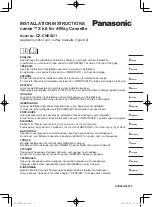
8
■
English
• When piping work is complete, it is necessary to perform a pressure test
and evacuate system with a vacuum pump.
• If using additional refrigerant, purge the air from the refrigerant pipes and
indoor unit using a vacuum pump, then charge additional refrigerant.
•
Use a hexagonal wrench (3/16 inch (4mm)) to operate the stop valve rod.
• All refrigerant pipe joints should be tightened with a torque wrench to the
specified tightening torque.
Compound
pressure gauge
Pressure
meter
High-pressure
valve
Gauge
manifold
Low-pressure
valve
Charging
hoses
Vacuum pump
Service port
Valve caps
Liquid
stop
valve
Gas stop valve
1) Pressurize the liquid pipe and gas pipe from the service ports of each stop valve to 604psi (4.17MPa) (do not pressurize
more than 604psi (4.17MPa)) for 1 hour minimum, 24 hours recommended. If there is a pressure drop, check for leaks,
make repairs and perform the pressure test again.
2) Connect the gauge manifold’s charging hose to the gas stop valve’s service port.
3) Fully open the low-pressure valve (Lo) on the gauge manifold and fully close the high-pressure valve (Hi).
(High-pressure valve will require no further operation.)
4) Evacuate system using vacuum pump to below 500 microns for 1 hour minimum.
5) Close the low-pressure valve (Lo) on the gauge manifold and stop vacuum pumping.
(Maintain this condition for a few minutes to make sure that the compound pressure gauge pointer does not swing
back.)*
1
6)
Remove the valve caps from the liquid stop valve and gas stop valve.
7) To open the liquid stop valve, turn the rod of the valve 90° counter-clockwise using a hexagonal wrench.
Close it after 5 seconds, and check for gas leakage.
Using soapy water, check for gas leakage from the indoor unit’s flare and outdoor unit’s flare and valve rods.
After the check is complete, wipe all soapy water off.*
2
8)
Disconnect the charging hoses from the service port for the gas stop valve, then fully open the liquid and gas stop valves.
(Do not attempt to turn the valve rods further than they can go.)
9) Tighten the valve caps and service port caps for the liquid and gas stop valves with a torque wrench to the specified
torques.
Refer to
“4. Refrigerant piping”
on page 6 for details.
*
1
If the compound pressure gauge pointer swings back, the refrigerant may have water content or there may be a loose
pipe joint.
Check all pipe joints and retighten nuts as needed, then repeat steps 3) through 5).
*
2
Under no circumstances shall potential sources of ignition be used in the searching for or detection of
refrigerant leaks.
A halide torch (or any other detector using a naked flame) shall not be used.
Do not use substances containing chlorine and electronic leak detection for gas leak detection.
English
01_EN_3P628775-3.indd 8
2021/02/09 13:40:06
































